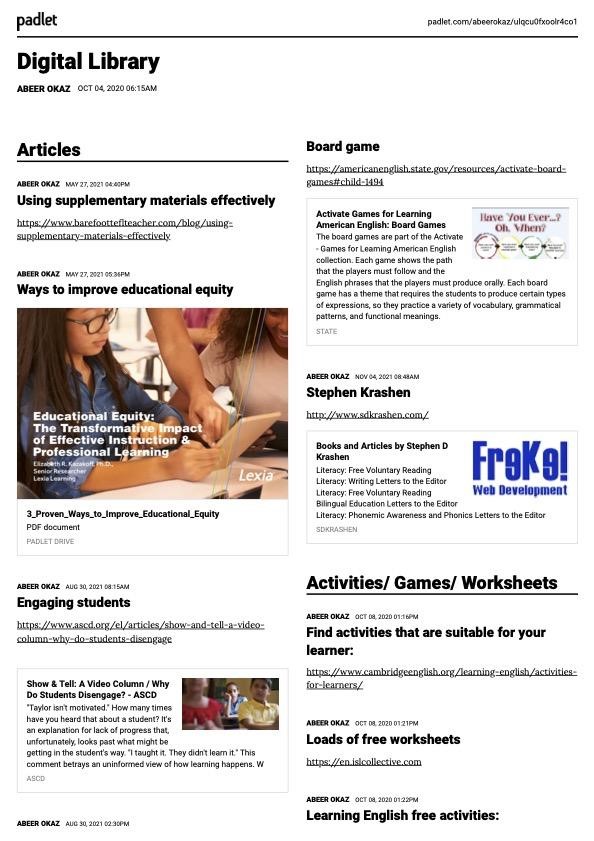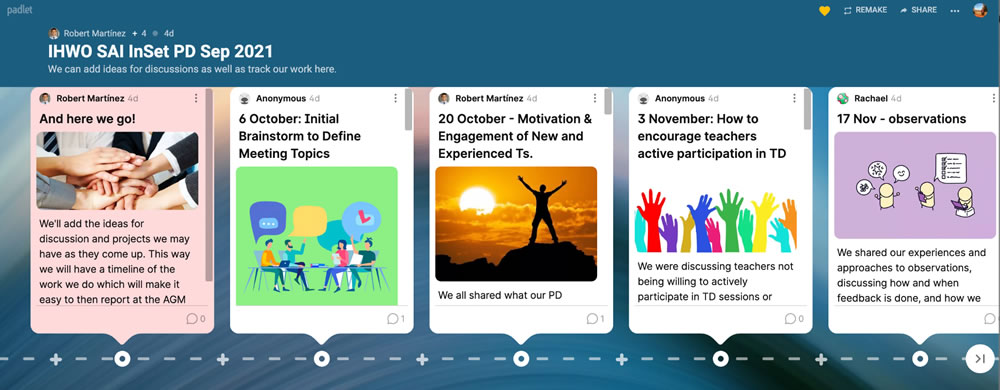A padlet (www.padlet.com) is place where you can create a single wall or multiple walls that are able to house all the posts you want to share.
In my own teaching experience, I find padlets magical because I can keep my posts, links, ebooks, comments, and much more all in one place. Note that you can only have three free padlets before upgrading to a pro account, which is a paid subscription.
There are so many ways to use padlets! Here are seven of my favorites:
1. Planning Interactive Lessons
If I am teaching a class with a SMART Board or a projector with internet, I can simply plan my whole lesson on the padlet and share the screen with my students. Conducting a lesson is easier when I have all my links embedded into my padlet. I can also share the content of my lessons with my students if they have their own devices simply by sharing my padlet. Here is an example of lessons for 6 days.
2. Collecting Students’ Writing
I borrowed this idea from a colleague who used to teach writing to students as preparation for their KET Cambridge Exam. Since then, I have been recommending Padlet to my trainees and teachers whenever they are giving writing tasks and need to encourage students to write individually and then give peer feedback. When students write on the padlet, they can see each others’ writings and thus use the comment box to give feedback easily. The same padlet can be used to include students’ writings accumulated from several lessons so that you can observe the progress. Here is an example.
3. Brainstorming Ideas
Every time I give a session on professional development, I create a padlet and encourage my attendees to fill in their ideas regarding realistic and feasible ways of developing as teachers. I share it later with them so they can resort back to it easily when they are looking for more professional development. See an example here.
4. Archiving Old Work and Creating a Digital Library
For the past 20+ years (i.e., when I started my teaching career), I was into the habit of copying and pasting links into word documents and then sending them to myself via email. The links were all related to websites or readings that I had come across and felt were important to keep. Most of the time, I would lose track of these emails. That was when I decided to use Padlet as my digital library. I started collecting all my readings, website, ebooks, workshops, and much more all in one place.

Click here to enlarge.
5. Connecting With My Teachers
During the COVID-19 lockdown when everyone shifted to online learning, it was very difficult to find common time slots to communicate with my staff to present useful tools for their online classes or to get their feedback on the feasibility and practicality of such tools. To address this problem, I started a padlet with all the tools we were considering and using and allowed my staff to comment and vote on the tools; this presented a great way to encourage teachers to voice their opinion.
6. Monitoring Development in Observations
One way of getting trainees to be engaged and active participants during peer observation is to assign them a task so they can observe and reflect. The trainer can post a question or a remark on a padlet and encourage trainees to observe and add their comments. In that way, the trainer ensures participation and the trainees do not forget what they wanted to share.
In other contexts, the same concept can be applied: Academic coordinators can use Padlet when assigning peer observation and use it to track the progress of a teacher. Teachers can also use the comments for self-reflection and/or to track their own progress. In the CELTA context, Padlet has helped trainees write their final assignment (“Lessons From the Classroom), when they are asked to reflect on their areas of strengths and those of improvement. Here is an example.
7. Meeting Minutes and Resource Packs
Through my work with the International House In Service Training Professional Development group meeting, I came to realize another use for Padlet. It is a great resource for archiving meeting information for all members of a professional group to access and reflect on. As you can see in the image, Robert Martínez has created a padlet with a brief of each of our meetings and a collection of teacher training resources. See it online here.

Click here to enlarge.
Conclusion
Padlet has shown its success in maintaining an active and participatory learning environment. Students, teachers, teacher trainees, and managers have a chance to collaborate, voice their opinions, and learn from each other. Padlet’s variety of features support inclusiveness, varied delivery, and freedom of expression.
|
Download this article (PDF) |
Abeer Okaz is the director of studies and educational consultant at Pharos University in Alexandria, Egypt. She is a teacher trainer, CELTA tutor, and a DELTA Module 2 TP tutor. She is a NILE and TransformELT consultant. She has 23 years of experience, 10 of which focused on strategic and organizational management and training in higher education. She has published in international journals and done training in Ireland, the United States, Saudi Arabia, Kyiv, and South Africa. Abeer has been presenting in international conferences since 2007.
| Next Article |
